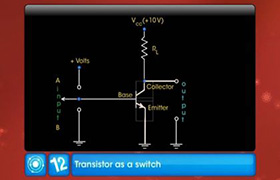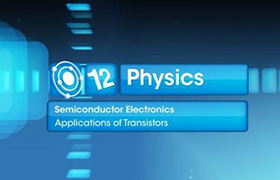CBSE Class 12-science Answered
If the common emitter current gain β∞ of the transistor used in the amplifier circuit shown is 200, What will the quiescent base current be equal to if the quiescent emitter current is 1 mA.

Asked by Topperlearning User | 10 Jul, 2014, 14:06: PM
In the common emitter mode, the current amplification factor (current gain) under no signal condition (βdc) is given by
βdc = IC/IB where IC is the collector current and IB is the base current (both under no signal conditions).
Since the collector current is almost equal to the emitter current IE (because of large value of βdc), we have
βdc ≈ IE/IB
Therefore IB ≈ IE/βdc =1 mA/200 = 0.005 mA = 5μA
Answered by | 10 Jul, 2014, 16:06: PM
Concept Videos
CBSE 12-science - Physics
Asked by Www.harshalhire51 | 20 Nov, 2019, 21:48: PM
CBSE 12-science - Physics
Asked by Topperlearning User | 10 Jul, 2014, 14:24: PM
CBSE 12-science - Physics
Asked by Topperlearning User | 24 Jun, 2014, 14:36: PM
CBSE 12-science - Physics
Asked by Topperlearning User | 01 Jul, 2014, 10:01: AM
CBSE 12-science - Physics
Asked by Topperlearning User | 10 Jul, 2014, 14:32: PM
CBSE 12-science - Physics
Asked by Topperlearning User | 10 Jul, 2014, 14:06: PM
CBSE 12-science - Physics
Asked by Topperlearning User | 10 Jul, 2014, 13:52: PM
CBSE 12-science - Physics
Asked by Topperlearning User | 10 Jul, 2014, 15:03: PM
CBSE 12-science - Physics
Asked by Topperlearning User | 01 Jul, 2014, 10:48: AM
CBSE 12-science - Physics
Asked by Topperlearning User | 04 Jun, 2014, 13:23: PM




 The adjoining figure shows a common emitter transistor amplifier which uses a silicon transistor. If the quiescent emitter current is 1 mA what is the base biasing voltage?
The adjoining figure shows a common emitter transistor amplifier which uses a silicon transistor. If the quiescent emitter current is 1 mA what is the base biasing voltage?